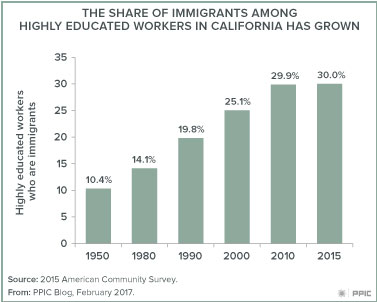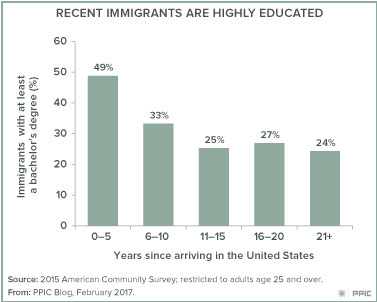
Immigrants are integral to California’s highly skilled workforce. As California’s demand for highly educated workers has outpaced the supply produced by its colleges and universities, immigrants have filled the gap. Immigrants now make up a substantial share of the state’s highly educated workers. Today, three of every ten highly educated workers in California is an immigrant, up from one in five in 1990. Immigrants are especially important in the state’s high tech sector, comprising 52% of college graduates who work in computer systems design and services and 57% of those in computer equipment and peripheral manufacturing (findings based on the 2013‒2015 American Community Survey).
Over time, the face of immigration to California has changed. Recent immigrants are more highly educated than immigrants who arrived earlier. In the past, most immigrants arrived from Latin America. But in recent years, most new immigrants to California are from Asia. Because many immigrants from Asia are highly educated, this regional shift has contributed to a change in immigrants’ education levels. Immigrants who have arrived in California in the past five years are among the most highly educated demographic group in the state, with more than half (52%) holding at least a bachelor’s degree, compared to 35% of US-born Californians.
 Immigrants to California from the seven countries that are the focus of President Trump’s executive order —Iran, Iraq, Libya, Somalia, Sudan, Syria, and Yemen—also tend to be highly educated. According to the 2015 American Community Survey, California is home to 305,000 immigrants from these countries—35% of the total number of immigrants from these countries in the nation—with most (213,000) from Iran. Altogether, almost half (47%) of adult immigrants (ages 25‒64) from these countries have a bachelor’s or graduate degree, including 54% of those from Iran.
Immigrants to California from the seven countries that are the focus of President Trump’s executive order —Iran, Iraq, Libya, Somalia, Sudan, Syria, and Yemen—also tend to be highly educated. According to the 2015 American Community Survey, California is home to 305,000 immigrants from these countries—35% of the total number of immigrants from these countries in the nation—with most (213,000) from Iran. Altogether, almost half (47%) of adult immigrants (ages 25‒64) from these countries have a bachelor’s or graduate degree, including 54% of those from Iran.
Given the contribution of highly educated immigrants to California’s economy, and especially to the state’s high tech sector, it is no wonder that many companies and state officials have raised concerns about the president’s executive order.
PPIC has projected that California faces a workforce skills gap and needs to increase the number of adults with a bachelor’s degree by an additional 1.1 million to meet workplace demands by 2030. These projections assume that the state will continue to attract substantial numbers of highly educated immigrants from abroad. Restrictions on the flow of those immigrants could exacerbate the projected workforce skills gap—and cause significant damage to the state’s economy.






